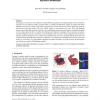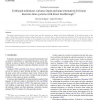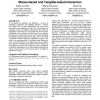DC
2008
13 years 4 months ago
2008
This study addresses the construction of a preset checking sequence that will not pose controllability (synchronization) and observability (undetectable output shift) problems whe...
COMBINATORICA
2008
13 years 4 months ago
2008
Consider the following seemingly rhetorical question: Is it crucial for a property-tester to know the error parameter in advance? Previous papers dealing with various testing prob...
CGF
2008
13 years 4 months ago
2008
The goal of texture synthesis is to generate an arbitrarily large high-quality texture from a small input sample. Generally, it is assumed that the input image is given as a flat,...
CGF
2010
13 years 4 months ago
2010
In this paper we present a novel method to compute Boolean operations on polygonal meshes. Given a Boolean expression over an arbitrary number of input meshes we reliably and effi...
AUTOMATICA
2007
13 years 4 months ago
2007
This paper extends previous work on joint input and state estimation to systems with direct feedthrough of the unknown input to the output. Using linear minimum-variance unbiased ...
AUTOMATICA
2007
13 years 4 months ago
2007
This paper addresses the problem of simultaneously estimating the state and the input of a linear discrete-time system. A recursive filter, optimal in the minimum-variance unbias...
ISSTA
2010
ACM
13 years 4 months ago
2010
ACM
Applications that process complex inputs often react in different ways to changes in different regions of the input. Small changes to forgiving regions induce correspondingly smal...
ACMIDC
2009
13 years 5 months ago
2009
We investigate the similarities and differences
WSC
2004
13 years 5 months ago
2004
An important step in designing stochastic simulation is modeling the uncertainty in the input environment of the system being studied. Obtaining a reasonable representation of thi...
WSC
2001
13 years 5 months ago
2001
Parameters of statistical distributions that are input to simulations are typically not known with certainty. For existing systems, or variations on existing systems, they are oft...



